Robert Marshall
Fulbright #385 to UK
June 30 – August 12, 2007
Disclaimer:
The purpose of this informal diary is to memorialize my observations and reflections during my 6-week stay in the UK. The intent is not to evaluate or rate any individual, program or organization; neither should these comments be taken to represent the positions, personal or official, of any person or organization. They are entirely my own creation and in the unavoidable event that they upset someone, I offer my most sincere apologies. Having said that, I hope that these observations will record both my personal and professional experiences during the Fulbright Senior Specialist program in the UK and will serve to remind myself and convey to others how fortunate I feel to have been given this opportunity for a professional and academic exchange, to meet these wonderful people and to visit so many fascinating places. I will try to remain faithful to a roughly daily entry, but already see how that may be a challenge after a long day of traveling to different public health sites or cultural attractions.
LONDON DIARY
June 30, 2007, Day 1:
We arrived at Heathrow Airport on Saturday at 6:30am after a long but uneventful night in the air. The sun came up at 5am and shined through the cabin windows; it was ‘way too early, according to our US timeclock, to be seeing the sunshine.
After a long hold on the runway, and a long line in immigration/customs, we headed for the “underground.” Somehow the £8 for the “tube” seemed more reasonable than the £40 each for a cab or shuttle. (I just learned how to make the English “pound” symbol!) We transferred at Kings Cross to the Northern line and made our way to the Borough Station —dragging our suitcases of course-- for a 5-minute walk to the “dorm”. It was a huge, fortress-like building on the street with a green, tarnished-copper tower roof.
I call it a dorm because during the school year, it houses students at the King’s College, London—which seems to be located all over this part of town—are area called Southwick, which is directly south of London Bridge, about a 15 minute walk from here. Part of the Fulbright procedure is for the sponsoring university to make housing available to the visiting scholar: so after a brief check in, we went into the cavernous inner courtyard, to the “block 9” entrance and up the elevator to the 4th floor.
The room is quite functional, with twin beds and a ship-style bath—one where the shower is not separated from the rest of the facilities, the water just goes all over the place—not that the place is that big to start with. It takes a bit of getting used to, but the ample hot water felt good after a long day of travel.
Since it as about 6am US time, we flopped on the bed and took a nice long nap to recapture our energy for the day. When we arose, we walked in a light rain (which sometimes got worse) north to London Bridge, the eastward past the Shakespeare theater and national theater along the Thames River. It is a spectacular sight! At the Waterloo Bridge, we took the stairs to the street and located the administration building for Kings College London (KCL), my academic sponsor. Its all looks so different from Brown and most other universities I’ve been to—probably because of the central urban setting. There we lines of multistoried buildings down most adjoining streets, but nothing that looked like a campus or “quad” in our sense of the word. Of course, I may just be showing my American ethnocentrism and may discover yet more wonders of this incredible place.
I have to admit, that after a long, long walk and dinner at a local pub (there are certainly plenty of those over here; we already made a list!) we turned in well-fed and with high expectations for our next day in London.
July 1, 2007, Day 2:
We weren’t nearly as rested as I thought and got off to a late start on Sunday, which turned out to be a cool, blustery and dry day. (One gent offered that he had not seen a rainy day in London in the past 20 years!). After a leisurely breakfast, including on the largest and best cups of coffee I have EVER had, we decided to take another even longer walk to a shopping center near a place called Canada Waters. (Unusual place names in this part of the world! One “tube” stop is called “CockFosters” and another is “Elephant and Castle.”) We walked for about 2 hours, cutting northeasterly across the Southwark section of London and through a residential peninsula area called Rotherhithe. This was filled with upscale condos and multi-family townhouses and other residences scattered between lovely parks and gardens. I later asked a passerby in the area about how to say this name, and still haven’t a clue. Anyway it was beautiful—the area, I mean (so was the “pint” in a local pub after a long walk).
We found the shopping center hidden behind a gigantic bowling alley and a couple of “American-style” restaurant/bars (like TGI Friday’s). The shopping was quite civilized, with a couple of dozen (or so) stores and a food court. The biggest attraction was the TESCA store, the modest equivalent of WalMart in the US. We purchased a pressed coffee maker, some coffee, a small desk fan, and a few other items, then backtracked to that American-style bar (this is where the “pint” came from that I mentioned earlier). Afterwards, we headed towards the Canada Waters underground station and learned that the name comes from a small lake formed by a canal from the Thames. That explained some of the drawbridges and other aquatic features we passed on our previous walk. After a short tube ride, we walked with our TESCO plastic bags back to the Great Dover Street Apartments, and tried out the fan (it worked good after I put it together!)
We crossed the street to the Truman Pub for dinner and access to the free wireless internet connection. We sent a couple of note home and got an immediate response from our daughter Alexis, wishing us well. After dinner, we walked north again to the London Bridge, then eastward along the Thames toward the Tower Bridge. It is truly magnificent at night, with the lights shining and the Tower of London in the background. They must have known we were there, because there was a 15 minute display of fireworks on the far side of the bridge, adding to the beauty of the evening. On the walk home, we found a restaurant for breakfast and planned to visit it soon—who knows, maybe tomorrow.
July 2, 2007, Day 3:
As Robbie Burns said, “the best laid schemes o’ mice an’ men gang oft’ agley. So we did not make the restaurant for breakfast but enjoyed some fresh “pressed” coffee in the kitchen next door and took our time getting out into the Monday bustle. We did walk up to the restaurant, but they stopped serving breakfast; so we went to a nearby breakfast bagel sandwich kiosk on the Thames and enjoyed the lovely view. I had already contacted Rowena, one of the program managers at the NSMC project and said that we were planning to stop by; so we hopped on the tube and made our way to Grovsnor Gardens.
The “Gardens” is a triangle-shaped park surrounded by rows of stately stone offices and just a stone’s throw from Buckingham Palace. (My dream of tea with the Queen may not be so far fetched after all.) Rowena met us on the 4th floor and spent a hour and a half orienting me to the project. As it turns out, England has nearly 50 million people who are the focus of the project. (Scotland, Wales and Northern Ireland have their own Departments of Health—some of which are doing similar projects). England is plagued by many levels of public health from the national ministry to the regional agencies and local health departments—even local service areas for the National Health Service. Thus, it faces many of the same problems of fragmented governmental levels as the US. Rowena and I traded professional stories and anecdotes for a while, getting to know each other. I found that we communicated quite well and were able to focus on some common professional ground rather quickly. We did some preliminary planning for field trips to Brighton and Cambridge next week. She introduced us to the others in the office, Denise, Steve, Patrick (Communications) and Aiden (the IT guy) and, of course, Sarah, the executive assistant—the ones who always seem to run the show.
Rowena had to attend a meeting so Linda and I left to explore the neighborhood a little before returning to the “dorm” for shorts and t-shirts. We later walked across the London Bridge to the northern side, then westward along the Thames pedestrian walk. At the Southwark Bridge we recrossed the river and stopped in a local pub (surprise) for dinner. I had steak and ale pie, both delicious and filling. We stopped on the way home to pick up some groceries and get ready for tomorrow.
July 3, 2007, Day 4
And what a day tomorrow turned out to be. We had cereal and “pressed” coffee in the communal kitchen and enjoyed a brief chat with some “pigment” scientists holding an exhibition at the Royal Society hall near Pall Mall.
After breakfast, I walked to the London Bridge station and took the tube to “work” at Grovsnor Gardens. Oh, yes, I purchased one of the Oyster cards that work electronically and give a discount rate (about ½ ) on the tube and busses. So the tube was less expensive but still hot and humid. After about a half-hour (and two changes) I arrived at Victoria station and walked the block to Number 20.
Aiden set up a desk and computer (with email and internet access—hooray!) in a vacant spot, but I hardly got a chance to use it before getting invited to a meeting to discuss “standards.” As it turns out, standards really refers to competency criteria in social marketing. This was one of Veronica’s assignment with help from Simon who was seconded (pronounced sec-KON-ded, meaning on loan) from another department. Veronica seemed very well oriented to the subject and brought some articles from various journals to inform the discussion. I offered to review one by Ed Maibach (GWU) about a framework for differentiating between the roles of communication and marketing as tools for public health. I thought it was quite useful and offered an excellent bibliography! I was quickly drawn into another meeting, but a subsequent conversation focused on adding a few items to the NSMS benchmarks—such as ethics, science research and a couple of others. The purpose of this is to offer a starting place for competency standards in social marketing for the NSMS—if not a larger collaborative of interests.
In the next meeting, Clive Blair-Stevens (NSAMC Deputy) briefed a colleague from Australia on the NSMS. Liz King works for the AUS Dept of Health and Aging in Sidney with some strong interests in youth and alcohol prevention. It was amazing to hear the similarities among the three of us about agencies, governments, policies, finances and other challenges. Clive described the roots of the NSMC in the Choosing Health documents and subsequent recommendations. Some of the success resulted from being there at the right place at the right time with the right people—especially at the senior and ministerial level. Of course, I imagine there was some hard, prolonged work that made this possible. He described how many government agencies were separated into policy, communication and research/development offices—often without much coordination or communication between them. He regards social marketing and the NSMC as a way of overcoming those challenges. They are planning a World Social Marketing Conference in April of 2008.
Next, I met with Dr. Peter Duncan, my “official sponsor” at Kings College London (KCL). We enjoyed a long talk about our backgrounds and the major challenges of our respective roles. He asked me to work on an approach to basic social marketing training for undergraduate students; I mentioned the CDCynergy materials and the NTCSM website from USF. He also asked me to talk individually with several of his colleagues in health promotion, research networking, preventive health practice and medical education. I am really looking forward to the interaction and expect to learn more than I offer in these discussions—since this is the way things have been going so far.
Wednesday July 4, 2007, Day 5
Is it a cultural faux pas to celebrate the 4th of July in England?
NSMC Team Meeting
[ Temporarily lost document: will add when retrieved].
Thursday, July 5th, 2007
Day 6
To Cambridge
Today we arose early and caught the train to Cambridge. It went through several neat-sounding towns like “Bishop’s Stanforth” and such over the 1 ¼ hour ride. Cambridge turned out to be everything one could imagine. The station bustled with people of all age; some clearly involving parents with young people checking out universities. We walked about a mile into the town and arrived at the market place, packed with people and stalls offering food and various retail goods.
After a quick lunch, we took the 2-hour walking tour of the area with Nancy, a 70-ish resident of the area. She took us to the nearby church with a Norman tower dating back many centuries. Nearby way the laboratory where Watson and Crick figures out the double-helix DNA and where the first splitting of the atom occurred. She mentioned how many Noble laurets were educated or worked at Cambridge—no wonder, with 32 independent colleges in the university. We explored the many side streets and peeked in of the college greens of Trinity College, Kings College, Clare College and several others.
The highlight of the trip (for me at least) was the Kings College Chapel, a wonderously elaborate structure of stone set in the middle of the campus. Nancy explained how some of the mason carved a little likeness of their face amongst some of the elegant sculpture along the walls. The ceiling alone is the largest unsupported stone-vaulted structure in the world, with 2000 tons of stone arching many stories over the sanctuary in a fan or web-like design. The wooden screen between the chapels (walnut) bore he initial of Henry VIII and even Queen Anne Boleyn—one of his ill-fated wives.
The real highlight for me came later with the service of choral music, including the traditional choir of boy sopranos. I’ve never quite heard a sound so beautiful and haunting. The execution was perfect and yet wonderfully penetrating and moving. My goose bumps cropped up prolifically—one of my sometimes reactions to excellent music.
Before heading for the train again, we stopped for a pint at the Eagle, the bar frequented by Watson and Crick, indeed the scene of their announcement about DNA. It was also recognized as one of the regular haunts of the RAF flyers during WWI and WWII.
Friday July 6th, 2007
Day 7
Office meeting and staff lunch
Saturday July 7th, 2007
Day 8
Excusion to St. Albans.
One of the colleagues at NSMC suggested an excursion to St. Albans, about 25 miles north of London, to view some Roman ruins. So today, Linda and I set out from London Bridge Station on the train toward a new destination.
We arrived at the St. Albans station after about 35 minutes and walked the mile into town. Again, we found a market square filled with people and stalls offering food, produce and many retail items. The tourist information office gave us a walking tour map and we set out toward our first destination.
The huge cathedral at St. Albans consists of several individual sections and chapels dating back to 1077AD. The oldest Norman section uses bricks “recycled” from the nearby Roman ruins. Subsequent sections were erected (and destroyed) by various nobels and kings during wars, neglect and pilferage to replenish the royal treasury. Central to the church is the shrine of St. Albans, the destination of many pilgrims during its day and destroyed by Henry VIII in 1539 and reconstructed in modern times.
Two highlights of the visit included a wedding in the “Lady Chapel” dedicated to the Virgin Mary in the 14th century, and a rehearsal by the cathedral choir, again including the boy sopranos.
Leaving the cathedral, we found our way to the roman ruins at Verulamium, set in the midst of a verdant expanse of park area. The ruins included both occasional walls, long sense stripped of the finished stone outer surfaces (something we noticed during a previous trip to Hadrian’s Wall on the border with Scotland), as well as an excavated roman city (Roman Theatre) located about ¼ mile away. The “hypoclaust” presents a stone mosaic floor from Roman times, including an enclosed underfloor heating system.
It was a beautiful day with bright sunshine and dry breeze and we decided not to push on any further; so we walk back to the town and returned to the train station. After the short ride back to London, we ate in a local pub and decided to replenish our strength for the following day.
Sunday July 8, 2007
Day 9
Something a little different today. Linda got a brochure on “Walks Around London” and we decided to take advantage of one dealing with a place known as “Little Venice.” This is an area in “northwest” London (?) around the Grand Union Canal, which connects the Docklands of London with Birmingham—a 3 weeks+ journey by horse-drawn canal boat.
We took the Bakerloo Line to Warwick Ave. and met up with a group of about 50 other participants. The area was quite upscale and lovely, with row upon row of stucco-faced attached homes. Shortly, we moved into the even more upscale detached mansions, which the guide informed us were often inhabited by movie stars and other famous people and cost in the many millions of pounds. Give the prices and exchange rate in London, about 2 to 1, I readily believed it.
It wasn’t always like this. Apparently in years past this area hosted many of London’s upscale bordellos. Several of the streets were named after Randolph Churchill (Winston’s father), and the addresses (13 Randolph Terrace) were often shortened to “number 13 Randy”—hence the origin of the term “randy” in the English language.
As we walked among the various neighborhoods, the architecture changed repeatedly from Victorian, to Edwardian to post WWII and even more modern. The highlight was the canal, lined with canal boats and house boats—including some refitted as restaurants, pubs, flower shops and sightseeing craft. We crossed back and forth on these delightful wrought iron bridges and stairs, getting a good chance to look down on the boats passing underneath. At one point on the tour, the guide pointed to an apartment house with the name “Fleming House.” He told the story about how Fleming accidentally discovered penicillin at the nearby Paddington Hospital, won the Nobel prize and had this complex named in his honor.
One thing I have discovered about touring (especially 2-hours on foot) is that enough can sometimes be too much, so at the end of the tour, Linda and I rested for a few minutes in a famous pub, with a pint, of course, gathering our energy for the tube ride home. Fortunately, the Bakerloo line goes right to Elephant and Castle station, which is on a short walk from our “dorm”. By the time we had dinner in the pub across the street, we were well-ready for bed and preparing for early Monday morning.
Monday-Tuesday, July 9-10
Day 10-11
Under the weather…..
Wednesday, 11 July 2007
Subscribe to:
Post Comments (Atom)

















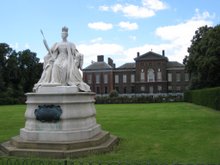
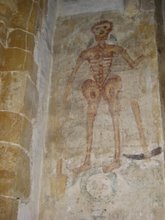
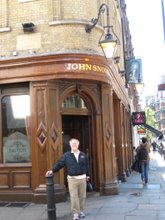
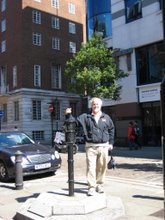
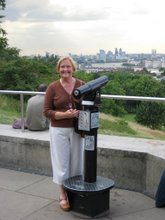
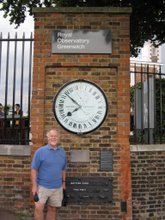
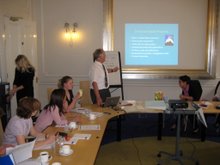
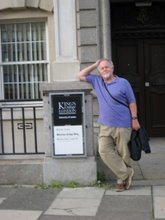

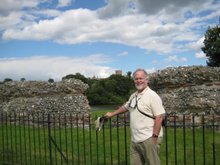
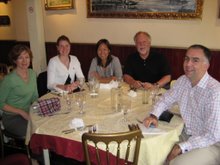
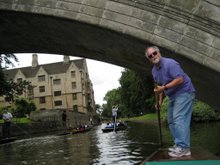
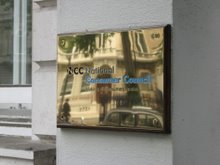
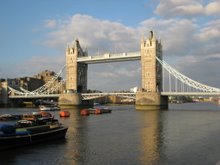
No comments:
Post a Comment